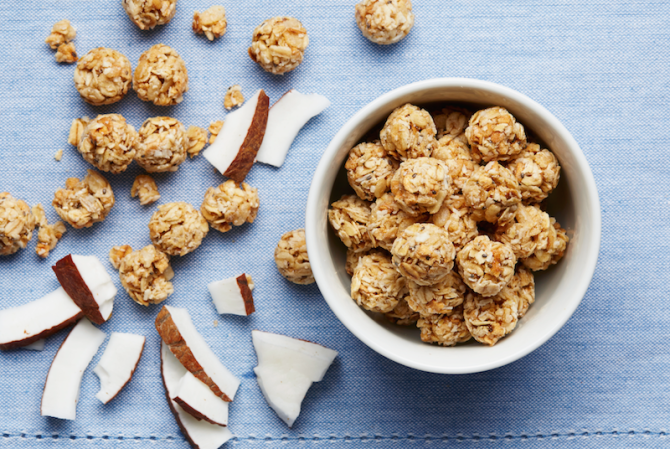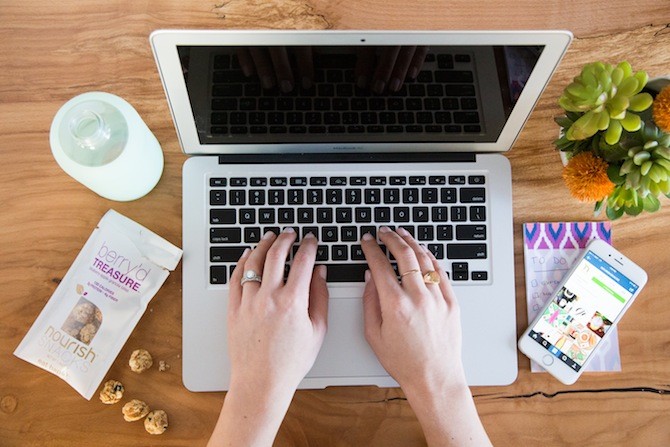You probably have no idea what you should be eating—we definitely didn’t when we were in college. So here are all the answers you’re dying to know. We asked all your burning questions to Joy Bauer, nutrition expert on NBC’s TODAY Show and co-founder of Nourish Snacks, the new food company that’ll change the way you snack.
1. Is breakfast really necessary?
Starting your day with a healthy breakfast will help fill your stomach with the high-octane fuel you need to power through a day full of classes and study sessions. Not to mention, it can help keep you from overdoing it at other meals.
For those mornings when you’re short on time (or you simply lose the battle with the snooze button), it helps to have speedy, energizing breakfast foods in your room so you don’t have to make the trip to the dining hall.
Microwaveable oatmeal is a simple option (bonus points if you top it with a sliced banana, dried fruit or chopped nuts and seeds). An apple with a portable pack of peanut butter (or almond butter) makes for a tasty and time-saving morning meal.
That said, some people simply don’t have an appetite in the morning. If that’s you, take note of how the rest of your day flows. If your energy isn’t lacking during the day and you aren’t scarfing down everything in sight because you’re famished, then perhaps you don’t really need breakfast.

Photo courtesy of Nourish Snacks
2. If we absolutely have to late-night eat (which, face it, we usually do), what should be our go to snack?
If your late-night nibbles consist of greasy chips and Red Bull, you’ll need a menu makeover. Try treats that leave you feeling energized and motivated instead of bloated and sluggish. Here are some delish ideas to get you started:
- Non-starchy veggies (like baby carrots, cucumber slices, sugar snap peas, or red bell pepper sticks) with low-cal dip (like low-cal ranch or reduced-fat balsamic vinaigrette), salsa or hot sauce (or for extra staying power, hummus or guacamole). And while baby carrots are a simple option, don’t forget about grape tomatoes, celery sticks, cauliflower, zucchini… you get the idea.
- Air-popped popcorn. Toss 1/4 cup of kernels into a brown paper bag, fold the edge to seal and microwave for roughly two minutes. Kick up the flavor with a few dashes of hot sauce—or, mist a batch of DIY popcorn with oil spray and top with some Parmesan, cinnamon, hot chili powder or truffle salt. No microwave? Grab a bag of ready-made light popcorn at the grocery store. Or, give Nourish Snacks half-popped non-GMO corn kernels a try—Mr. Popular or Hot & Popular, if you like it spicy.
- Fresh or frozen grapes are juicy and sweet, plus they cost only about 100 calories per cup. Pick purple grapes—they hit you with a dose of brain-boosting antioxidants.
- Smart-sipping tip: Skip the pricey energy drinks and stick with coffee or green/black tea (cup for cup, tea contains half the caffeine as coffee, so feel free to double your dose).
3. What alcoholic beverages contain the least amount of sugar?
Alcohol itself isn’t loaded with lots of sugar—it’s really the mixers you’ll want to watch out for. Added fruit juices, sodas, sour mixes and simple syrups can top off your glass with a ton of unwanted calories. When it’s time for a cocktail (for those of you over 21, of course), opt for a shot of hard liquor (like vodka or gin) mixed with club soda, and just a splash of 100 percent fruit juice. It’ll cost you less than 120 cals and cut your sugar intake.
If mixed drinks aren’t your thing, grab a 12-oz. beer (preferably light), or pour yourself a glass of wine or champagne (5-oz.). And in case you’re wondering, a typical “shot” of hard liquor clocks in at about 80 calories. No matter which booze you choose, alternate your alcoholic bevy with water or seltzer to keep yourself hydrated (and minimize bad decision-making later on).
4. What is the best dish to order at a bar without being a party pooper?
Look for key words like broiled, grilled, roasted or steamed. Grilled fish tacos, chicken fajitas (hold the sour cream, pile on the salsa), shrimp cocktail, vegetarian and turkey chili, turkey burgers, and crudité with hummus or guacamole all fit the bill.
Also, you can save lots of calories by asking for sauce on the side, getting a side salad instead of the fries, or splitting an entrée with a pal (totally wallet-friendly, too).

Photo courtesy of Nourish Snacks
5. What’s the best snack to eat after a workout?
For most people who perform moderate-intensity exercise for less than an hour a day, a small snack that’s between 100 to 200 calories within 60 minutes of finishing a workout is really all that’s needed.
In a perfect world, you want a light munchie that offers some protein and carbs: An orange with a small handful of almonds, an apple with a string cheese, a container of Greek yogurt, or a bag of Nourish Snacks—from Menage-a-Mix to Mind Your Ps and BBQs, they’re each perfectly portioned and loaded with the good stuff.
Almond to Cherries and Sweet & Salty Kapow are snacks with an extra bonus, thanks to the addition of tart cherries, which have been shown to help muscles recover faster after workouts, according to research. Delicious and effective—nice deal.
But here’s some non-negotiable advice: Don’t forget to guzzle water. Good ol’ H2O is your best bet for rehydrating after working out, so grab at least 2 cups (or a 16-oz. bottle) and gulp it down when you finish up at the gym.
Order your snacks now with the code SpoonFeed to get 10% off.
This post is sponsored by Nourish Snacks.
Want some more nourishment? Check out these articles:



